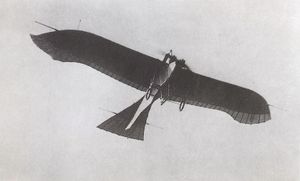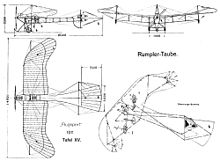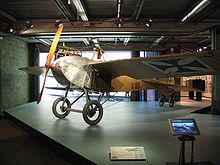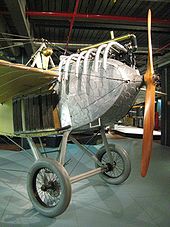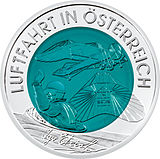- Etrich Taube
-
Etrich-Rumpler Taube Role Fighter, Bomber, Surveillance, and Trainer Manufacturer Various Designer Igo Etrich First flight 1910 Primary user Luftstreitkräfte The Etrich Taube, also known by the names of the various manufacturers who build versions of the type, such as the Rumpler Taube, was a pre-World War I monoplane aircraft. It was the first mass-produced military plane in Germany. As Imperial Germany's first practical military aircraft, the Taube ("dove") was used for virtually all military aircraft applications, as a fighter, bomber, surveillance aircraft and trainer from 1910 until the start of World War I in August 1914.
The Taube was very popular prior to the First World War, and it was also used by the air forces of Italy and Austria-Hungary. Even the Royal Flying Corps operated at least one Taube in 1912. On November 1, 1911, Giulio Gavotti, an Italian aviator, had dropped the world's first aerial bomb from his Taube monoplane over the Ain Zara oasis in Libya.[1] Once the war began, it quickly proved inferior as a serious warplane and as a result was soon replaced by newer and more effective designs. There were reports of later use however, including reports of Taube's bombing Broadstairs in Kent early in 1917.[2]
Contents
Design and development
The Taube was designed in 1909 by Igo Etrich of Austria-Hungary, with its first flight in 1910. It was licensed for serial production by Lohner-Werke in Austria and by Edmund Rumpler in Germany, now called the Etrich-Rumpler-Taube.[3][4] Rumpler soon changed the name to Rumpler-Taube, and stopped paying royalties to Etrich, who subsequently abandoned his patent.
Despite its name, the Taube's unique wing form was not modeled after a dove, but was copied from the Zanonia macrocarpa seeds, which float to the ground in a slow spiral caused by a single wing. Similar wing shapes were also used by Karl Jatho. Etrich had tried to build a flying wing aircraft based on the Zanonia wing shape, but the more conventional Taube type, with tail controls, was much more successful.
Etrich adopted the format of crosswind-capable main landing gear that Louis Blériot had used on his Blériot XI cross-channel monoplane for better ground handling, and gained biplane-like strength for the Taube's monoplane wing with a cable cross-braced, orthogonal-layout Brücke, or "bridge", beneath each wing panel, which often carried small wire-spoke wheels or skids at its outboard ends, for wingtip protection. Later Taube-type aircraft from other manufacturers would eventually replace the Blériot-style crosswind main gear with a simpler V-strut main gear format, and also omitted the underwing "bridge" structure for somewhat better aerodynamic efficiency.
Like many contemporary aircraft, especially monoplanes, the Taube used wing warping rather than ailerons for lateral (roll) control, and also warped the rear half of the stabilizer for use as an elevator control surface's function. Only the vertical, twinned triangular rudder surfaces were usually hinged.
Operational history
The design provided for very stable flight, which made it extremely suitable for observation. In addition, the translucent wings made it difficult for ground observers to detect a Taube at an altitude above 400 meters. The French called it "the Invisible Aircraft", and it has been referred to as the "world's first stealth plane". The first hostile engagement was by an Italian Taube in 1911 in Libya, its pilot using pistols and dropping 2 kg bombs. The plane was also used for bombing in the Balkans in 1911, and in late 1914 when German 3 kg bomblets and propaganda leaflets were dropped over Paris.Taube spotter planes detected the advancing Imperial Russian Army in East Prussia during the World War I Battle of Tannenberg.
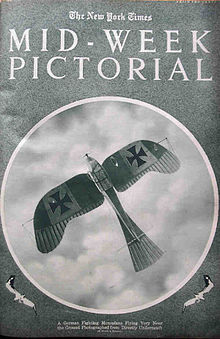 Front page of the New York Times Mid-Week Pictorial, January 1st 1917. Caption reads: "A German Fighting Monoplane Flying Very Near the Ground Photographed from Directly Underneath." The aircraft is of the Taube type, either a Rumpler Taube or a copy from one of the other manufacturers involved in Taube production.
Front page of the New York Times Mid-Week Pictorial, January 1st 1917. Caption reads: "A German Fighting Monoplane Flying Very Near the Ground Photographed from Directly Underneath." The aircraft is of the Taube type, either a Rumpler Taube or a copy from one of the other manufacturers involved in Taube production.
During World War I, Imperial German units stationed at Qingdao, Shandong, China only had one operational aeroplane, the Rumpler Taube piloted by Lieutenant Gunther Plüschow, to face the attacking Japanese, who had with them a total of eight. On October 2, 1914, Plüschow's Taube attacked the Japanese warships with two small bombs, but failed to score any hits. On November 7, 1914, shortly before the fall of Qingdao, Plüschow was ordered to fly top secret documents to Shanghai, but was forced to make an emergency landing at Lianyungang, where he was interned by a local Chinese force. Plüschow was rescued by local Chinese civilians under the direction of an American missionary, and successfully reached his destination at Shanghai with his top secret documents, after giving the engine to one of the Chinese civilians who rescued him.
Poor rudder and lateral control made the Taube difficult and slow to turn. The aeroplane proved to be a very easy target for the faster and more mobile Allied fighters of World War I, and just six months into the war, the Taube was removed from the front lines and used to train new pilots. Many future German aces would learn to fly in a Rumpler Taube.
Variants
Due to the lack of license fees, a total of no less than 14 companies built a large number of variations of the initial design, making it difficult for historians to determine the exact manufacturer based on historical photographs. An incomplete list is shown below. The most common version was the Rumpler Taube with two seats.
- Albatros Taube
- Produced by the Albatros Flugzeugwerke
- Albatros Doppeltaube
- Biplane version produced by the Albatros Flugzeugwerke.
- Aviatik Taube
- Produced by the Automobil und Aviatik AG firm.
- DFW Stahltaube (Stahltaube)
- Version with a steel frame.
- Etrich Taube
- Produced by the inventor Igo Etrich.
- Etrich-Rumpler-Taube
- Initial name of the "Rumpler Taube".
- Gotha Taube
- Produced by the Gothaer Waggonfabrik as the LE.1, LE.2 and LE.3 (Land Eindecker - "Land Monoplane") and designated A.I by the Idflieg
- Harlan Pfeil Taube
- Halberstadt Taube III
- Produced by the Halberstadt.
- Jeannin Taube (Jeannin Stahltaube)
- Version with a steel tubing fuselage structure.
- Kondor Taube
- Produced by the Kondor.
- RFG Taube
- Produced by the Reise- und Industrieflug GmbH (RFG).
- Roland Taube
- Rumpler-Taube
- Produced by Edmund Rumpler, Luftfahrzeugbau.
- Rumpler Delfin-Taube (Rumpler Kabinentaube "Delfin")
- Version with a closed cabin, produced by Edmund Rumpler, Luftfahrzeugbau.
- Isobe Rumpler Taube[5]
- A Taube built in Japan by Onokichi Isobe
Operators
- Two units were ordered by Chinese revolutionaries to fight Imperial Qing China, but when the they reached Shanghai in December, 1911 with other Taube airplanes ordered by Imperial German forces stationed in China, the Imperial Qing dynasty had already been overthrown and the airplanes did not have the opportunity to participate in the battle.
Survivors and flyable reproductions
The Technisches Museum Wien is thought to have the only known remaining Etrich-built example of the Taube in existence, an early enough example to have a four-cylinder engine powering it,[6] and is potentially a twin to Gavotti's Taube aircraft from 1911, also said to have been powered with a four-cylinder inline engine. Other examples of original Taubes exist, such as one in Norway, which was the last original Taube to fly under its own power in 1922, over a Norwegian fjord.
The Owl's Head Transportation Museum in Owls Head, Maine USA, is so far the only known museum to attempt the construction of a flyable reproduction of the Etrich Taube in North America. Their example first flew in 1990, and it still flies today with the power of a 200 hp Ranger L-440 inline-6 "uprighted" air-cooled engine.[7]
Specifications (Rumpler Taube)
General characteristics
- Crew: two
- Length: 9.9 m (33.5 ft)
- Wingspan: 14.3 m (45.83 ft)
- Height: 3.2 m (10.5 ft)
- Wing area: 32.5 m² (280 ft²)
- Empty weight: 650 kg (950 lb)
- Max takeoff weight: 850 kg (1,200 lb)
- Powerplant: 1 × 4-cylinder Argus or 6-Cylinder Mercedes Typ E4F, 74 kW (99 hp)
Performance
- Maximum speed: 100 km/h (60 mph)
- Range: 140 km (86 miles)
- Service ceiling: 2,000 m (10,000 ft)
Armament
- Rifles and pistols
- Hand dropped bombs
See also
References
- ^ Johnston, Alan (10 May 2011). "Libya 1911: How an Italian pilot began the air war era". BBC News. http://www.bbc.co.uk/news/world-europe-13294524.
- ^ entry for 1 March, Tommy's War, A First World war Diary by Thomas Livingstone, published 2008 by Harper Press
- ^ "Lohner Etrich-F Taube OE-CET". Virtual Aviation Museum. http://www.khs.at/aviaticum/6.htm. Retrieved 2011-04-25.
- ^ "Lohner Etrich-F Taube OE-CET". Virtual Aviation Museum. http://www.khs.at/aviaticum/7.htm. Retrieved 2011-04-25.
- ^ Mikesh, Robert and Shorzoe Abe. Japanese Aircraft 1910–1941. London: Putnam, 1990. ISBN 0-85177-840-2
- ^ "Igo Etrich (1879-1967) - Die Etrich-II-Taube". Technisches Museum Wien. http://www.tmw.ac.at/default.asp?id=259&al=Deutsch. Retrieved 2011-04-25.
- ^ "1913 Etrich Taube (Replica)". Owls Head Transportation Museum. http://www.ohtm.org/etrich.html. Retrieved 2011-04-25.
Bibliography
- Mikesh, Robert and Shorzoe Abe. Japanese Aircraft 1910–1941. London: Putnam, 1990. ISBN 0-85177-840-2
External links
- "Aircraft 'Made in Germany'" (PDF). Flight VI (34): 877 etc.. August 21, 1914. No. 295. http://www.flightglobal.com/pdfarchive/view/1914/1914%20-%200877.html. Retrieved June 13, 2011. Article describing German aircraft types available at the start of World War One, Specific Taube models are on p. 880 (Albatros), pp. 897–899 (D.F.W., Etrich), pp. 922–924 (Goedecker, Gotha, Halberstadt, Hansa, Harlan), pp. 939–940 (Jatho, Jeannin, Kondor), and p. 958 (Rumpler).
- Etrich Taube
- Rosebud's Archive with many Photos
- Owl's Head Transportation Museum-flyable reproduction 1913 Etrich Taube
- Pictures of the Lohner Etrich-F Taube (and other planes)
- Walkaround photos of the Vienna museum's early Etrich Taube, by Andy Szekeres
- Video of the Owl's Head reproduction Taube
KuKLFT A-class aircraft designations Idflieg A-class aircraft designations Lists relating to aviation General Aircraft (manufacturers) · Aircraft engines (manufacturers) · Airlines (defunct) · Airports · Civil authorities · Museums · Registration prefixes · Rotorcraft (manufacturers) · TimelineMilitary Accidents/incidents Records Categories:- German fighter aircraft 1910–1919
- German bomber aircraft 1910–1919
- German military reconnaissance aircraft 1910–1919
- German military trainer aircraft 1910–1919
- Military aircraft of World War I
- Propeller aircraft
- Single-engine aircraft
Wikimedia Foundation. 2010.

